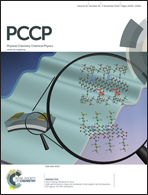Probing framework–guest interactions in phenylene-bridged periodic mesoporous organosilica using spin-probe EPR†
Abstract
The pore walls of phenylene-bridged periodic mesoporous organosilicas (B-PMOs) can be crystal-like or amorphous depending on the synthesis conditions. Here, spin-probe electron paramagnetic resonance (EPR) is used to monitor the adsorption of nitroxide radicals on three types of B-PMO with varying pore size and wall characteristics. Nitroxide radicals with varying polarity are chosen as probes to mimic guest molecules with different properties. The study shows that the B-PMO materials with amorphous walls allow an overall better adsorption of the spin probes than the one with crystalline walls, independent of the nature of the spin probe. The effect of hydration of the guest–host system on the mobility of the spin probe molecule depends more on the nature of the spin probe than on the B-PMO material. Comparison of the spin-probe adsorption on B-PMOs and ethylene-bridged PMO materials shows the sensitivity of the mobility of the guest molecule to the nature of the organic group.


 Please wait while we load your content...
Please wait while we load your content...